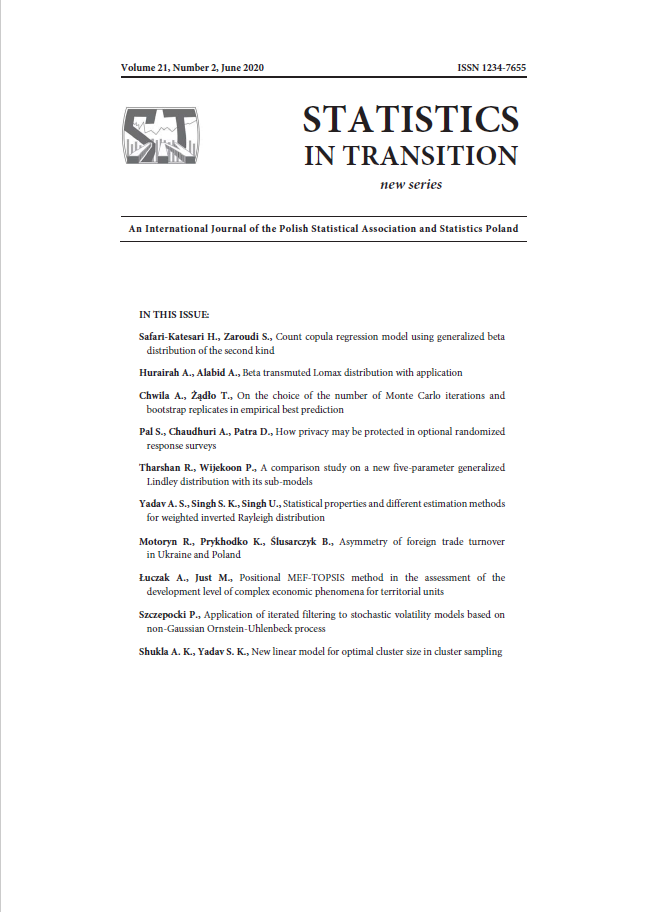ARTICLE
ABSTRACT
Modelling claims severity for obtaining insurance premium is one of the major concerns of the insurance industry. There is a considerable amount of literature on the actuarial application of the copula model to calculate the pure premium. In this paper, we model claims severity for computing the pure premium in the collision market by means of the count copula model. Moreover, we apply a regression model using a generalized beta distribution of the second kind (GB2) to compute the premium for an average claim and the conditional computation for all coverage levels. Like many other researchers, we assume that the number of accidents is independent from the size of claims. For real data application, we use a portfolio of a major automobile insurer in Iran in 2007-2008, with a subsample of 59,547 policies available in their portfolio. We then proceed to compare the estimated premiums with the real premiums. The results demonstrate that there is strong positive dependency between the real premium and the estimated one.
KEYWORDS
count copula, GB2 regression, pure premium, collision insurance
REFERENCES
AVANZI, B., TAYLOR, G., WONG, B., YANG, X., (2019). A Multivariate Micro-Level Insurance Counts Model With a Cox Process Approach, UNSW Business School Research Paper, (2019ACTL02).
CHERUBINI, U., LUCIANO, E., VECCHIATO, W., (2004). Copula methods in finance. John Wiley and Sons.
DAVID, M., (2015). Auto insurance premium calculation using generalized linear models, Procedia Economics and Finance, 20, pp. 147–156.
DICKSON, D. C., (2016). Insurance risk and ruin. Cambridge University Press.
FREES, E. W., VALDEZ, E. A., (1998). Understanding relationships using copulas, North American actuarial journal, 1; 2(1), pp. 1–25.
FREES, E. W., VALDEZ, E. A., (2008). Hierarchical insurance claims modeling, Journal of the American Statistical Association, 103(484), pp. 1457–1469.
FREES, E. W., JIN, X., LIN, X., (2013). Actuarial applications of multivariate two-part regression models, Annals of Actuarial Science, 7(2), pp. 258–287.
JOE, H., (2014). Dependence modeling with copulas. Chapman and Hall/CRC.
KATESARI, H. S., VAJARGAH, B. F., (2015). Testing Adverse Selection Using Frank Copula Approach in Iran Insurance Markets, Mathematics and Computer Science, 15, pp. 154–158.
KATESARI, H. S., ZARODI, S., (2016). Effects of Coverage Choice by Predictive Modeling on Frequency of Accidents, Caspian Journal of Applied Sciences Research, 5, pp. 28–33.
KLEIBER, C., KOTZ, S., (2003). Statistical size distributions in economics and actuarial sciences, Vol. 470, John Wiley and Sons.
LESMANA, E., WULANDARI, R., NAPITUPULU, H., SUPIAN, S., (2018). Model estimation of claim risk and premium for motor vehicle insurance by using Bayesian method, In IOP Conference Series: Materials Science and Engineering (Vol. 300, No. 1, p. 012027), IOP Publishing.
MARTON, J., KETSCHE, P. G., SNYDER, A., ADAMS, E. K., ZHOU, M., (2015). Estimating premium sensitivity for children’s public health insurance coverage: selection but no death spiral, Health services research, 50(2), pp. 579–598.
MCDONALD, J. B., BUTLER, R. J. (1987). Some generalized mixture distributions with an application to unemployment duration, The Review of Economics and Statistics, pp. 232–240.
SCHIRMACHER, E., (2016). Pure Premium Modeling Using Generalized Linear Models, Predictive Modeling Applications in Actuarial Science: Volume 2, Case Studies in Insurance, 1.
SHI, P., VALDEZ, E. A., (2011). A copula approach to test asymmetric information with applications to predictive modeling, Insurance: Mathematics and Economics, 49(2), pp. 226–239.
SHI, P., (2016). Insurance ratemaking using a copula-based multivariate Tweedie model, Scandinavian Actuarial Journal, 2016(3), pp. 198–215.
SHI, P., YANG, L., (2018). Pair copula constructions for insurance experience rating, Journal of the American Statistical Association, 113(521), pp. 122–133.
SUN, J., FREES, E. W., ROSENBERG, M. A., (2008). Heavy-tailed longitudinal data modeling using copulas, Insurance: Mathematics and Economics, 42(2), pp. 817– 830.
SKLAR, M., (1959). Fonctions de repartition an dimensions et leurs marges, Publ. inst. statist. univ. Paris, 8, pp. 229–231.
WEISBERG, H. I., TOMBERLIN, T. J., (1982). A statistical perspective on actuarial methods for estimating pure premiums from cross-classified data, Journal of Risk and Insurance, pp. 539–563.
WOLNY-DOMINIAK, A., WANAT, S., SOBIECKI, D., (2018). Modelling Quantile Premium for Dependent LOBs in Property/Casualty Insurance, In Finance and Sustainability, Springer, Cham, pp. 265–272.
YANG, Y., QIAN, W., ZOU, H., (2017). Insurance premium prediction via gradient tree-boosted Tweedie compound Poisson models, Journal of Business and Economic Statistics, pp. 1–15.
ZAROUDI, S., BEHZADI, M. H., FARIDROHANI, M. R., (2018a). Application of Copula in Life Insurance, International Journal of Applied Mathematics and Statistic, 57(3), 162–168.
ZAROUDI, S., FARIDROHANI, M., BEHZADI, M., (2018b). A Copula Approach for Finding the Type of Dependency with Mortality Force Function in Insurance Market, Journal of Advances and Applications in Statistics, 53(2), pp. 103–121.
ZHANG, X., YIN, W., WANG, J., YE, T., ZHAO, J., (2015). Crop insurance premium ratemaking based on survey data: a case study from Dingxing county, China, International Journal of Disaster Risk Science, 6(3), pp. 207–215.
